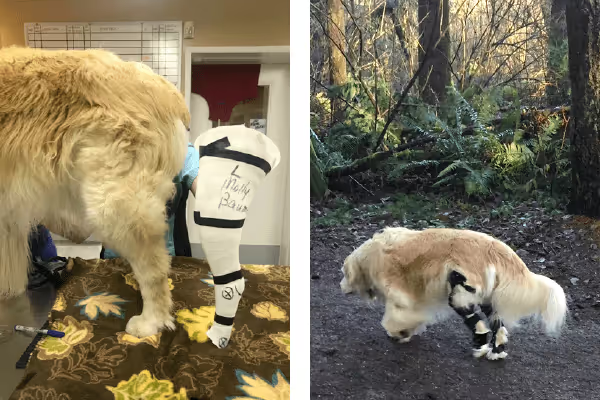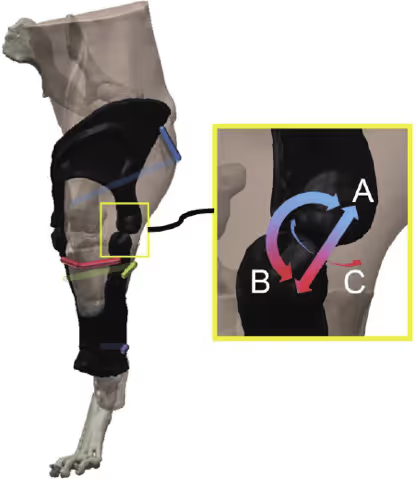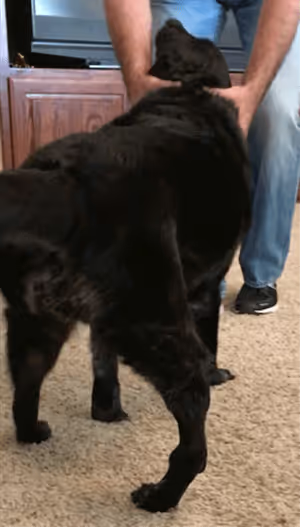A Spot Speaks Blog Share: Cruciate Ligament Disease: A Comparison of Surgical and Nonsurgical Treatment Outcomes
Please read the following blog by Dr. Nancy Kay of Spot Speaks! You can read all of her blogs at: www.speakingforspot.com
Cruciate Ligament Disease: A Comparison of Surgical and Nonsurgical Treatment Outcomes

I was intrigued by the results of a recently published study in which the researchers focused on cranial cruciate ligament disease (CCLD) in dogs. Specifically, they evaluated owner satisfaction with outcomes of two very different treatment options, one involving surgery and the other using a custom fitted brace (orthosis).An all too common injuryThe cranial cruciate ligament is vital for maintaining stability within the knee joint (stifle). Tearing of this ligament is ridiculously common, particularly in medium and large sized dogs.In most cases, the tear occurs abruptly, often in association with exercise or activity. It results in a sudden onset of lameness with the dog often unwilling to bear any weight on the affected leg. More and more, we are learning that neutering before one year of age predisposes to cruciate ligament disease, at least in some breeds. This association has been clearly documented inLabradors, Golden Retrievers, Vizslas, and German Shepherds.Traditional treatment recommendationsAs far back as I can remember, surgical repair has been the primary recommendation veterinarians make for treatment of CCLD in medium and large sized dogs.The recommendation for nonsurgical management (restricted activity, a knee brace, anti-inflammatory drugs, pain medications, the tincture of time) is usually reserved for smaller dogs with the thinking that, the lighter the load carried by the knee, the less there is a need to restore “perfect” function. For medium and larger sized dogs nonsurgical management is typically the “go to” when there are extenuating circumstances such as financial constraints, anesthesia risks, advanced age, concurrent diseases, opposition to surgery, or an inability to successfully manage post-operative care. And, these extenuating circumstances commonly arise.Study designThe researchers distributed online surveys to people whose dogs were treated for CCLD. The questions were developed to evaluate their overall satisfaction with treatment outcomes. All the dogs were medium to large sized dogs and all were treated via one of the following two methods:
- Surgical treatment with tibial plateau leveling osteotomy (TPLO) procedure
Of the many types of surgeries used to repair torn cruciate ligaments, the TPLO has long been regarded as a gold standard. This surgery has an excellent track record for restoring normal function and minimizing development of arthritic changes within the knee.TPLO surgery is performed almost exclusively by veterinarians who specialize in surgery. The operation is quite pricey, particularly for dogs who end up tearing ligaments in both knees (happens approximately 50% of the time). TPLO post-operative care is laborious involving a lengthy period of confinement and controlled activity for the dog. (I know this to be true from much personal experience!) The TPLO complication rate is reported to be less than 7%, and most of the complications resolve with appropriate treatment.
- Nonsurgical treatment with a custom made knee joint orthosis (brace)
With the recent rise in access to canine rehabilitation therapy (the equivalent of physical therapy in the world of human medicine), the use of custom fit orthoses (braces) to treat dogs with CCLD has grown in popularity.Study resultsOf the 1,022 surveys distributed, 309 were completed- 203 from the orthosis group and 76 from the TPLO group. There were no significant differences between body weight, size, and age of dogs between the two groups.Factors influencing treatment decisionsThe factors that most influenced the decision to treat with an orthosis rather than surgery were cost, convenience, and personal preference. Amongst the TPLO respondents, veterinarian recommendation was stated to be the most influential factor.Treatment outcomesThe proportion of respondents who reported that their dog’s treatment outcome was excellent, very good, or good was higher (98%) within the TPLO group compared to the orthosis group (86%). The percentage of respondents who reported that their dogs had either mild or no lameness following treatment was also higher in the TPLO group (98%) than in the orthosis group (88%).ComplicationsForty-six percent of respondents in the orthosis group reported that medical attention was required for skin problems caused by the brace. The need for multiple orthosis adjustments was commonly reported. By comparison, only 4% of respondents from the TPLO group reported complications requiring medical attention.Customer satisfactionOverall satisfaction ratings were pretty much identical with 85-90% of respondents from bothgroups reporting that, given the chance, they would choose the same treatment again.ConclusionsPlenty of prior studies have evaluated CCLD surgical outcomes. This study is one of the first providing well-researched data pertaining to a nonsurgical treatment option.The results are thought provoking for me on a few different levels:
- I was surprised that, despite the fact that reports of a normal gait (no lameness) and ratings of outcomes were significantly lower in the orthosis treated group, these respondents reported a high level of satisfaction and willingness to make the same choice all over again.
- I was surprised that, in spite of the very high complication rate associated with orthosis treatment (46%), respondents reported a high level of satisfaction with this treatment plan and a willingness to make the same choice again.
- Prior to reading this study, I would have assumed that nonsurgical treatment for CCLD would have resulted in lower customer satisfaction. I would have been wrong. My notion is that the high level of satisfaction within the orthosis group was related to good communication between veterinarians and clients about realistic expectations.
So, how is all of this information relevant to dog lovers and the veterinarians who advise them? It makes a strong case for veterinarians spending time in the exam room discussing all CCLD treatment options with their clients rather than focusing solely on surgery.Despite the sentiment that surgery is the best treatment choice for CCLD, in many cases, this option simply isn’t feasible. Kudos to the researchers involved in this study for choosing to evaluate a nonsurgical alternative.Has your dog ever torn a cruciate ligament? If so, what did you opt to do and what was the outcome?Best wishes,Nancy Kay, DVMDiplomate, American College of Veterinary Internal MedicineAuthor of Speaking for Spot: Be the Advocate Your Dog Needs to Live a Happy, Healthy, Longer LifeAuthor of Your Dog’s Best Health: A Dozen Reasonable Things to Expect From Your VetRecipient, Leo K. Bustad Companion Animal Veterinarian of the Year AwardRecipient, American Animal Hospital Association Animal Welfare and Humane Ethics AwardRecipient, Dog Writers Association of America Award for Best BlogRecipient, Eukanuba Canine Health AwardRecipient, AKC Club Publication Excellence AwardBecome a Fan of Speaking for Spot on FacebookPlease visit http://www.speakingforspot.com to read excerpts from Speaking for Spot and Your Dog’s Best Health. There you will also find “Advocacy Aids”- helpful health forms you can download and use for your own dog, and a collection of published articles on advocating for your pet’s health. Speaking for Spot and Your Dog’s Best Health are available athttp://www.speakingforspot.com, Amazon.com, local bookstores, and your favorite online book seller.





